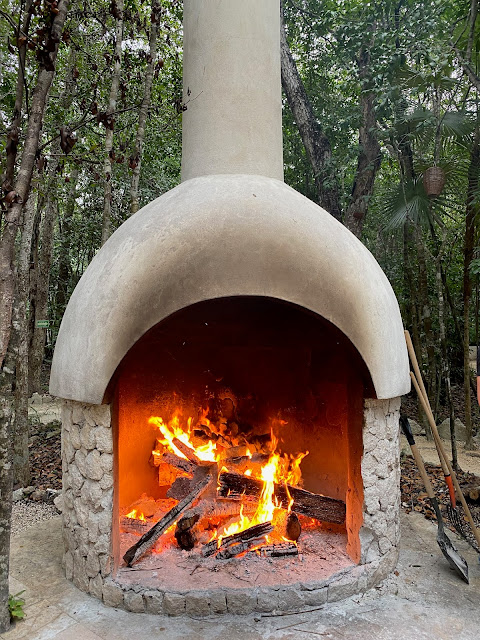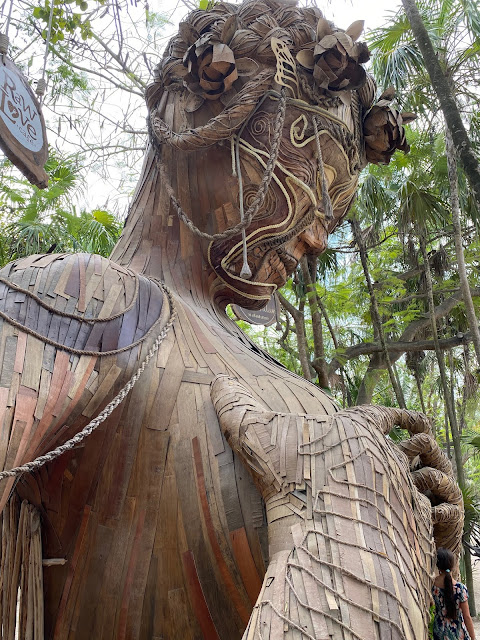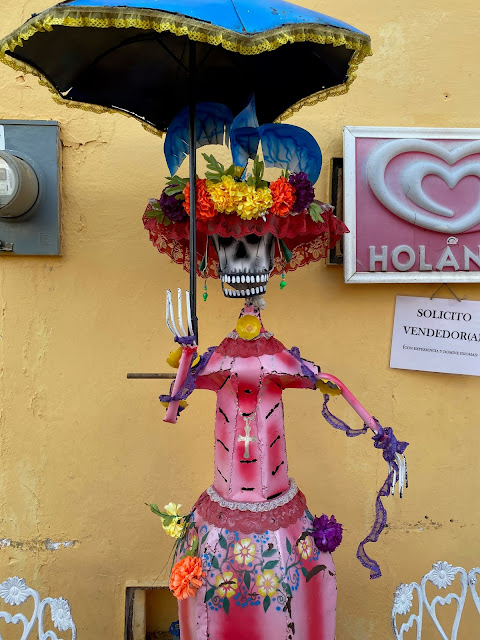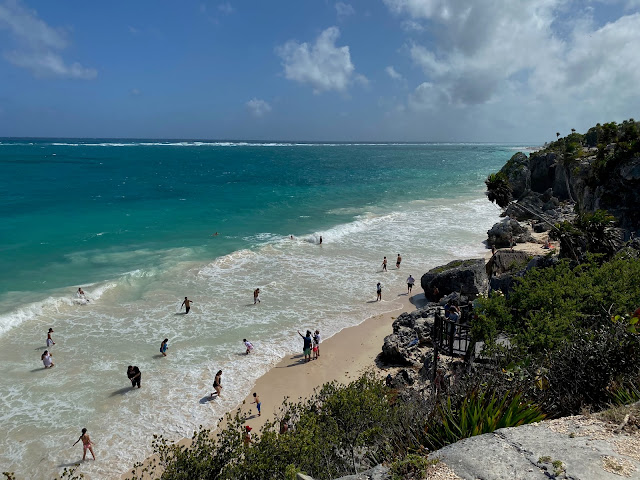5 Things I Liked About Tulum
During this Apocolypse or #Covid19 pandemic as it's more commonly known, I've been on a mission to give positivity more of my attention. I mean, the alternative simply isn't an option anymore. It feels like we're bouncing around in Pandora's Box and every other day we discover a new horror. Therefore, I've decided to use all of my energy and brainpower (what's left of it after this neverending pandemic) to focus only on the positive. So here goes, I'll list the things I liked about the tourist trap-extraordinaire: Tulum.
I'll tell you. It's a pit or sinkhole created by Mother Earth when limestone collapses, the surface caves in forming a pit and then exposes groundwater for us to swim in. Or for the ancient Mayans to throw their sacrificial offerings in. Today, it's mostly used for swimming and epic Instagram photos.
Scientist have discovered that cenotes, which are different in size, can also be interconnected to form a series of underground cave systems spanning several miles. Today, up to 6000 cenotes have been discovered in the Yucatan Peninsula alone.
Now, if splashing in a beautiful natural pool that could be connected to an adventurous underground cave that's possibly riddled with skeletons, isn't fun for you, then I don't know what will please you people. For me, it was an ethereal experience. The color of the water was intense, the ambiance was ancient and the surrounding nature was breathtaking. It felt like a privlige being able to waddle in those waters. On my birthday we visited, Gran Cenote, the largest cenote Tulum has to offer and it was truly one of the highlights of the trip.
Picture it: You're descending down a winding staircase in to cave. At the bottom you find yourself gaping at sparkling blue waters while overhead, part lush vegetation and part cave, hovers over you. Once you settle into the water, it's not too hot, not too cold - just right, you slip on your flippers and suck your goggles onto your face. You then dip your head underwater and find baby turtles swimming below your feet. You come up to shriek with excitement, when you notice you've ventured further into the cave and it's become slightly darker and you can swear you spot something in the corner of your eye. It's a bat! No, make that plural. Dozens of bats are hanging high above your head while fish and turtles are swimming below your toes. It's straight out of a nature documentary and you're loving every moment of it.
That's what it's like to swim in a cenote.




Way back when in Mesoamerica, the locals mostly use this type of sweat lodge as a wellness practice to heal and purify their bodies after a tough ball game, pretty much like a sauna is used today in Europe. But it was also used to heal sick people, improve circulation and sometimes even for women to give birth in. Now, that's where I would draw the line, but I'm pretty much down for all the other stuff. Little did I know, that this wouldn't just be a sweat session in the dark, it would also become the starting point of a spiritual rebirth for me. But I'm getting ahead of myself. Let's start with the basics.
There is a 16th century illustrated Aztec codex that pictures a temazcal experience below. It looks painful and a bit unnerving, but now when I look at it, I can see the intensity and each character's different emotions being portrayed. Some are angry, some cry while others are scared or amused. That's human emotions for you - it's messy. And that's what the modern-day temazcal is all about: reconnecting with your inner child and facing any pent-up emotions.
It started with all of us scantly clothed and individually throwing a handful of crystalized copal resin on to burning volcanic stones, while setting an intention for the journey we were about to embark upon. We then crawled one-by-one into a dark, damp makeshift pizza oven and once inside we sat in a circle around a fire pit. The temperature was still very meek because all the hot volcanic stones are still frying outside on the BBQ.
The environment and even the shape of the hut is made to represent the mother's womb and every hot stone that's brought inside represents our grandmothers (abuelitas in Spanish). We would say “welcome, the grandmother rock" (Bienvienidos abuelita piedra!), every time a stone was brought in. It's believed that these grandmothers have been here for years together with our other ancestors and will be our companions during this journey.
1. Cenotes
Ceno-what now? It's pronounced, sə-nō′tē, or if the phonetic alphabet is like Greek to you, watch here how to say it like a local. Why is it so important to pronounce correctly? Well, because after you've experienced the magic that's a cenote and come to love them fiercely, you'd also be offended when you hear someone mispronounce it.
So, what's this foreign word and why is it something you love about Tulum, Jumé?
Scientist have discovered that cenotes, which are different in size, can also be interconnected to form a series of underground cave systems spanning several miles. Today, up to 6000 cenotes have been discovered in the Yucatan Peninsula alone.
Now, if splashing in a beautiful natural pool that could be connected to an adventurous underground cave that's possibly riddled with skeletons, isn't fun for you, then I don't know what will please you people. For me, it was an ethereal experience. The color of the water was intense, the ambiance was ancient and the surrounding nature was breathtaking. It felt like a privlige being able to waddle in those waters. On my birthday we visited, Gran Cenote, the largest cenote Tulum has to offer and it was truly one of the highlights of the trip.
Picture it: You're descending down a winding staircase in to cave. At the bottom you find yourself gaping at sparkling blue waters while overhead, part lush vegetation and part cave, hovers over you. Once you settle into the water, it's not too hot, not too cold - just right, you slip on your flippers and suck your goggles onto your face. You then dip your head underwater and find baby turtles swimming below your feet. You come up to shriek with excitement, when you notice you've ventured further into the cave and it's become slightly darker and you can swear you spot something in the corner of your eye. It's a bat! No, make that plural. Dozens of bats are hanging high above your head while fish and turtles are swimming below your toes. It's straight out of a nature documentary and you're loving every moment of it.
That's what it's like to swim in a cenote.




2. Temazcal
I'm a sucker for a good wellness experience. So when I heard about an ancient ritualistic sweat lodge, called a temazcal, naturally, I signed up as fast as I could.Way back when in Mesoamerica, the locals mostly use this type of sweat lodge as a wellness practice to heal and purify their bodies after a tough ball game, pretty much like a sauna is used today in Europe. But it was also used to heal sick people, improve circulation and sometimes even for women to give birth in. Now, that's where I would draw the line, but I'm pretty much down for all the other stuff. Little did I know, that this wouldn't just be a sweat session in the dark, it would also become the starting point of a spiritual rebirth for me. But I'm getting ahead of myself. Let's start with the basics.
There is a 16th century illustrated Aztec codex that pictures a temazcal experience below. It looks painful and a bit unnerving, but now when I look at it, I can see the intensity and each character's different emotions being portrayed. Some are angry, some cry while others are scared or amused. That's human emotions for you - it's messy. And that's what the modern-day temazcal is all about: reconnecting with your inner child and facing any pent-up emotions.
The environment and even the shape of the hut is made to represent the mother's womb and every hot stone that's brought inside represents our grandmothers (abuelitas in Spanish). We would say “welcome, the grandmother rock" (Bienvienidos abuelita piedra!), every time a stone was brought in. It's believed that these grandmothers have been here for years together with our other ancestors and will be our companions during this journey.
We did four rounds of loading volcanic stones on the fire pit. Each time, the shaman would open the heavy cloth that covered the door, we chanted for more grandmothers, and soon prepare ourselves for the heavy darkness to swallow the room and finally, the stones would hiss as the shaman poured an herb mixture with water onto the stones so the hot steam embraced us. The aim of each session is for the heat and steam to channel through our bodies and cast out any negative emotions/experiences via sweat and exhalation.
Each session was called a door (puerta) and every door brought more heat and steam than the one before. Each round brought us closer to rebirth from all our negative experiences. The first door signifies confidence. The second, emotions. Here we were encouraged to simply let go and see what emotions came through. If we wanted to cry, we could, the same with laughing or screaming. The third door represents the warrior in each of us. Our shaman gave us a chant, "soy un guerrero" or "soy una guerrera" (I am a warrior) that roared through the hut. The final door represents rebirth, where we all screamed at the top of our lungs to rid ourselves of any leftover bad energy, this was followed by blissful silence - each of us soaking up the last bit of steam and reveling in sweet exhaustion.
Somewhere between the second or third door, you're so into the interval chanting in Spanish and constant downpour of sweat, that you start to lose track of time and everyone around you. You are sitting only with yourself while everyone else's voice is just a background hum. For the longest time there was only the darkness, the steam, my abuelitas, and me.
Each session was called a door (puerta) and every door brought more heat and steam than the one before. Each round brought us closer to rebirth from all our negative experiences. The first door signifies confidence. The second, emotions. Here we were encouraged to simply let go and see what emotions came through. If we wanted to cry, we could, the same with laughing or screaming. The third door represents the warrior in each of us. Our shaman gave us a chant, "soy un guerrero" or "soy una guerrera" (I am a warrior) that roared through the hut. The final door represents rebirth, where we all screamed at the top of our lungs to rid ourselves of any leftover bad energy, this was followed by blissful silence - each of us soaking up the last bit of steam and reveling in sweet exhaustion.
Somewhere between the second or third door, you're so into the interval chanting in Spanish and constant downpour of sweat, that you start to lose track of time and everyone around you. You are sitting only with yourself while everyone else's voice is just a background hum. For the longest time there was only the darkness, the steam, my abuelitas, and me.
You also lose all inhibition and start releasing feelings you've mastered at hiding deep inside. Many balled their eyes out next to me, but I wasn't concerned, I was completely swept up in my own emotions and wonderment with why I've never done this before.
A temazcal is a symbolic regression to the mother’s womb and reconnecting with the inner child and this was never more apparent than at the end when you slowly crawl backward out the hut into the night - simulating being born. You leave the hut feeling absorbed in silence, your body utterly relaxed and your mind as light as a feather.
A short side note: two days after this transcendent experience, I returned to work only to find we all had to go into lockdown due to the Covid. During these past months, I have ventured on amazing self-growth experiences largely thanks to this cleansing ritual in the temazcal. Soy una guerrera!One thing everyone can say about Tulum is that it's very colorful. I saw graffiti and murals around every corner, in restaurants and hidden in back alleys. There are beautiful fountains and churches in surrounding towns, clear centote pools, multicolor flowers popping through every crevice, and my favorite by far is the illustrious Tulum lady.
I'm the only one who calls her that. She's actually a wooden installation called Ven a la Luz (come into the light) and was sculpted by a fellow South African, Daniel Popper. As I mentioned, she is mostly made out of wood and rope, but her torso overflows with lush vegetation, which creates an archway leading to Ahau Tulum - a swanky resort that's every bohemian and vegan's wet dream.

We visited all of these types, naturally. I won't overwhelm you with the vivid and curious history of all of these ruins, but I will share some fun facts. I mean, no one likes to just look at decrepit buildings without some sort of context.
These ruins are overrun by tourists and very big lizards but they are absolutely worth the trip, because if there's only going to be one Mayan city by the sea, then it was going to the spectacular. The Mayans definitely knew the expression "Go big or go home". Buildings lead all the way up the steep cliffs towering over dramatic views of a neverending ocean. It's breathtaking.

I only want to tell you about the big kahuna in Chichen Itza: El Castillo (the castle). This pyramid style building dwarfs the other structures in the city (no, I didn't climb this one, I had already reached my steps for that day in scouring the larger than life grounds). It's also known as the Temple of Kukulcan. Kukulcan was a Mayan feathered snake god (yikes). A really cool event takes place every Spring and Autumn equinox. At around late afternoon, a series of triangular shadows dance across the northern side of the pyramid that, with a little help from your imagination, looks a bit like a snake wriggling its way down the 98 ft (30 meters) staircase. Kukulcan has come for a visit. Scientists believe that the Mayans purposefully built the pyramid in its specific unique way to record the equinoxes.
I got to see dragons part-take in a good fight, work on their tan, romance a partner and enjoy sweet dreams all in within a few steps. I didn't have to travel far to spot one scurry away into the jungle, no these dragons lounged without a care in the world and with complete disregard for all the gawking tourists. Technically, they're called ctenosauras or spinytail iguanas. Dragons sound cooler, so I'll just stick to that.
So, sit back and enjoy this incredible montage of the dragons of Tulum.

A short side note: two days after this transcendent experience, I returned to work only to find we all had to go into lockdown due to the Covid. During these past months, I have ventured on amazing self-growth experiences largely thanks to this cleansing ritual in the temazcal. Soy una guerrera!One thing everyone can say about Tulum is that it's very colorful. I saw graffiti and murals around every corner, in restaurants and hidden in back alleys. There are beautiful fountains and churches in surrounding towns, clear centote pools, multicolor flowers popping through every crevice, and my favorite by far is the illustrious Tulum lady.
I'm the only one who calls her that. She's actually a wooden installation called Ven a la Luz (come into the light) and was sculpted by a fellow South African, Daniel Popper. As I mentioned, she is mostly made out of wood and rope, but her torso overflows with lush vegetation, which creates an archway leading to Ahau Tulum - a swanky resort that's every bohemian and vegan's wet dream.

4. Mayan ruins
Who doesn't love some culture? Come to the Yucatan Peninsula, we have ruins! There are ruins for everyone. Ruins in the jungle. Ruins in the open plains. Ruins on a cliff overlooking the ocean. Ruins galore!We visited all of these types, naturally. I won't overwhelm you with the vivid and curious history of all of these ruins, but I will share some fun facts. I mean, no one likes to just look at decrepit buildings without some sort of context.
Tulum Ruins
Did you know that every Mayan city was built with a specific purpose in mind? The ruins in Tulum used to be a seaport, trading mainly in turquoise and jade. It is also the only Mayan city you'll find next to the coast. Being so close to shore made the city vulnerable to invasion, so the Mayan leaders decided to build a wall around the city - making it also one of the very few Mayan cities to be walled in. It's a special place, to say the least.These ruins are overrun by tourists and very big lizards but they are absolutely worth the trip, because if there's only going to be one Mayan city by the sea, then it was going to the spectacular. The Mayans definitely knew the expression "Go big or go home". Buildings lead all the way up the steep cliffs towering over dramatic views of a neverending ocean. It's breathtaking.
Coba ruins
Coba has a primeval feel to it. Sprawled throughout the jungle, many people rent bicycles to get from one site to the next. It feels wild and unspoiled. Towering over the tree canopies is Coba's pyramid, the second-highest temple in the Mayan world and the highest in Mexico and I totally dominated that beast just to share the below photo with all of you. You're welcome.

Chichen Itza
Last, but certainly not least, is what's fondly known as "chicken pizza" in my household, the champion of ruins: Chichen Itza. Let me start by telling you, it's large. You'll need a full day, loads of water and very comfy shoes to tackle this sight. This gigantic city was in the forefront of political and economic activity in Mayan culture. Roughly around 600 A.D the metropolis was already one of the largest cities in the Mayan world. It stretched nearly two square miles sporting a densely packed commercial and residential area. Fun fact: many archeologists think that the Mayans painted their cities in bright colors, but due to time and erosion, the remains we see today is a pale gray of the original stone.I only want to tell you about the big kahuna in Chichen Itza: El Castillo (the castle). This pyramid style building dwarfs the other structures in the city (no, I didn't climb this one, I had already reached my steps for that day in scouring the larger than life grounds). It's also known as the Temple of Kukulcan. Kukulcan was a Mayan feathered snake god (yikes). A really cool event takes place every Spring and Autumn equinox. At around late afternoon, a series of triangular shadows dance across the northern side of the pyramid that, with a little help from your imagination, looks a bit like a snake wriggling its way down the 98 ft (30 meters) staircase. Kukulcan has come for a visit. Scientists believe that the Mayans purposefully built the pyramid in its specific unique way to record the equinoxes.
5. Wildlife
Want to hear something that will really blow your mind? My hate for snakes is well known, but I get giddy when I see large lizards. My husband once had to chase after me when I deliriously ran into the jungle after a Komodo dragon in Malaysia. I don't want to touch them, I know their jaws are steel traps and they're basically snakes with legs, but I simply can't control childlike joy when I spot one. I just want to sit and look at them. I find them extremely fascinating. And to my joy, I got to play spot the lizard in Tulum, because the area is overrun by them.I got to see dragons part-take in a good fight, work on their tan, romance a partner and enjoy sweet dreams all in within a few steps. I didn't have to travel far to spot one scurry away into the jungle, no these dragons lounged without a care in the world and with complete disregard for all the gawking tourists. Technically, they're called ctenosauras or spinytail iguanas. Dragons sound cooler, so I'll just stick to that.
So, sit back and enjoy this incredible montage of the dragons of Tulum.























































Comments
Post a Comment
Thanks for your input!